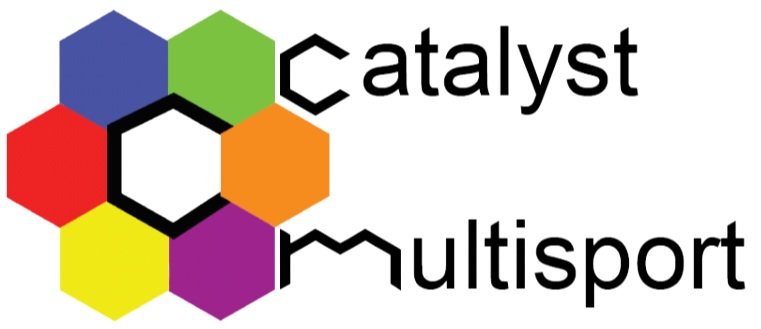The Holy Trinity of Triathlon Training and Racing
Triathlon is, of course, made up of three distinct disciplines—but being strong in each doesn't necessarily guarantee success. To truly excel in triathlon, you need more than just fitness; you need to race smart. That’s where the Holy Trinity of Triathlon comes into play. This trinity consists of the Mental, Internal (Physiological), and External (Physical) aspects of racing.
All three components—mental, internal, and external—must be monitored throughout the entire event. This becomes even more critical the longer the race or the more challenging the conditions, especially in the heat. Let’s take a closer look at each and how they show up in both training and on race day.
Mental: Rate of Perceived Effort and Awareness
Most athletes are familiar with the concept of RPE (Rate of Perceived Exertion)—your personal sense of how hard you’re working. At Catalyst, we use the classic 0–10 scale, which aligns well with the talking test to gauge effort.
Developing a strong sense of RPE is crucial because gadgets can fail—and if they do, you’ll need to rely on your own internal cues to stay on track with your race plan.
In sprint races, RPE hovers around 8–9 throughout, especially near the finish. As race distance increases, perceived effort will naturally be lower at the start but build due to accumulating fatigue with your external output, power/pace being unchanged. This effect is amplified in hot conditions, where what feels like a 4–5 on a cool day might shoot up to 8–9 in the heat, even at the same pace or power—especially on the run.
Race Day Tip:
Build into your race—don’t blast out like you’ve been shot from a cannon and then crumble later. In shorter races, yes, it’s "pedal to the metal," but as distances lengthen, pacing and awareness become critical. If you're at an 8 out of 10 halfway through the Ironman bike or run, you're likely headed straight for the hurt locker—or worse, a DNF.
Heat also alters how you feel from the very start. As your core temperature rises, your RPE will go up even if your pace stays the same. That’s why RPE is such a valuable pacing tool, especially in warm conditions.
Key takeaway:
Check in with yourself regularly during the race. Keep your RPE in a sustainable range and adjust based on feel—not just data.
Internal/Physiological: Heart Rate and Other Considerations
With all the gadgets we now have—bike and run power meters, advanced smartwatches, etc.—heart rate (HR) has been pushed to the sidelines. But when it comes to long-course racing, that’s a big mistake, especially in the heat.
For my long-course athletes, I typically set a hard cap on heart rate. This helps ensure you can execute your race plan and reach the finish line strong—even if pace or power metrics drop.
Another internal consideration:
Gastrointestinal (GI) distress. While not a direct performance metric, it can derail your race. As effort and heat rise, gastric emptying slows, meaning you may need to adjust your fueling strategy to avoid stomach issues.
Other physiological changes to keep in mind:
VO2max decreases with heat
Time to exhaustion shortens
Core temperature and sweat rate increase
RPE feels higher at the same output
Key takeaway:
Use HR as a reality check. It gives you a clear picture of how hard your body is working—even when power or pace say otherwise.
External/Physical: Power and Pace
This is the most visible aspect—and often the one most athletes fixate on. But focusing too much on pace or power at the expense of RPE and HR can sabotage your race.
Power and pace should be viewed as guidelines, not absolute targets. Conditions like wind, rain, terrain, and especially heat can throw a wrench into even the best-laid plans. A 20mph headwind, for instance, could make holding a goal pace unrealistic—and trying to force it could destroy your race.
Even power, while easier to maintain than pace, isn’t immune. Trying to hit target wattage in the heat might force you above your ideal RPE or HR zones, leading to early burnout.
Key takeaway:
Don’t be a slave to the numbers. Use power and pace as tools, but always keep them in check with what your body and heart rate are telling you.
Putting It All Together: A Balanced Race Plan
Success in triathlon doesn’t hinge on a single metric—it’s about balancing all three: RPE, HR, and Pace/Power. If one is out of alignment with the others, it's time to adjust. The longer the race and the hotter the temps, the more critical this becomes.
Here’s a sample framework for a 11–12 hour Ironman:
Swim:
RPE: Feels steady, high Zone 2 (4/10)
Bike:
RPE: 3–5 out of 10 (high Zone 2)
Power: 70–75% of FTP
HR: 80–83% of Threshold HR (THR)
Run:
RPE: 2–4 out of 10 (mid Zone 2)
Pace: 80–82% of Threshold Pace (THP)
HR: 82–84% of THR
Note: These values are based on mid-to-late stages of the bike and mid stage of the run. You should expect RPE and HR to rise over time, with the goal of maintaining pace and power as long as possible.
Here is a more visual presentation with AeT being your aerobic threshold, in and around Zone 2. While RPE is represented in a 6-20 scale, 6 is very light, 2-3/10 and 12 being light up to maxed out by the end of the run.
Final Thoughts
Don’t anchor your race strategy to a single number. Success—both in performance and enjoyment—comes from syncing your mental, internal, and external cues. That’s the Holy Trinity of Triathlon.
If you’d like help building a personalized race plan based on these principles, feel free to reach out at CoachTed@catalystmultisport.life or use [this link] to schedule a time to Chat with Coach Ted.
Best of luck in your upcoming race season! I hope this approach helps you hit your goals—and maybe even exceed them.
– Coach Ted






